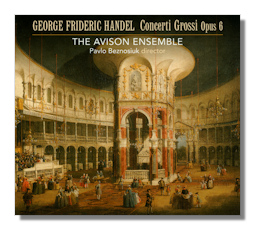
The Internet's Premier Classical Music Source
Related Links
- Handel Reviews
- Latest Reviews
- More Reviews
-
By Composer
-
Collections
DVD & Blu-ray
Books
Concert Reviews
Articles/Interviews
Software
Audio
Search Amazon
Recommended Links
Site News
 SACD Review
SACD Review
George Frederic Handel

Concerti Grossi for 2 Violins, Cello,
Strings & Continuo, Op. 6
- Concerto Grosso #1 in G Major, HWV 319
- Concerto Grosso #2 in F Major, HWV 320
- Concerto Grosso #3 in E minor, HWV 321
- Concerto Grosso #4 in A minor, HWV 322
- Concerto Grosso #5 in D Major, HWV 323
- Concerto Grosso #6 in G minor, HWV 324
- Concerto Grosso #7 in B Flat Major, HWV 325
- Concerto Grosso #8 in C minor, HWV 326
- Concerto Grosso #9 in F Major, HWV 327
- Concerto Grosso #10 in D minor, HWV 328
- Concerto Grosso #11 in A Major, HWV 329
- Concerto Grosso #12 in B minor, HWV 330
The Avison Ensemble/Pavlo Beznosiuk
Linn CKD362 3 Hybrid Multichannel SACDs
Corelli's set of 12 Concerti Grossi was largely responsible for the interest in that form in Britain during the first years of the eighteenth century. These of Handel, his Op. 6, played here with panache and style by The Avison Ensemble under Pavlo Beznosiuk on a three-CD set show such an influence… the third (and last) allegro of Number 1 in G Major [CD.1 tr.5], for example, could almost be by the Italian – had it a lighter touch. Indeed, it's hardly too cynical to acknowledge that John Walsh, Handel's publisher in London, encouraged the composer to write in the form concerto grosso himself in order to exploit the works' popularity with a public ever eager for new and more exciting musical experiences. This Op. 6 set – also 12 in number – dates from 1739, which is actually 25 years after those of Corelli.
Like those of Corelli, this Op. 6 set (Handel gave it the same opus number as had Corelli also in homage to him) is scored for a concertino of two violins and cello complemented by four part ripieno strings with continuo. Although Handel's works display a fair variety in structure, they typically follow the sonata da chiesa sequence; that is, show-fast-slow-fast movements. Several of the Op. 6 set have five or six movements, though. Various of this set's opening movements have the dotted rhythms so beloved of the French court. Was Handel hedging his bets? Fugues and dance movements abound – as do borrowings not only from Handel's own work, but also that of Scarlatti and Muffat.
This is lively and energizing music, then. It is infused with the new, the ear-grabbing and the enticing. While The Avison Ensemble is technically well on top of its every nuance, twist and turn, there are places when they distinctly lack vivacity and punch. Not follow through, for there's a delightful consistency to their approach. But that extra special infusion of freshness that's always nice to distinguish playing is sometimes missing.
Indeed, there is almost a tendency to drag… in the otherwise haunting andante of the Opus 3 in E minor [CD.1 tr.11], for example. This is not unduly profound music; it doesn't set out to expound life's mysteries. But nor is it light music where the listener is left to supply any idea of purpose. Each theme, melody and arrangement of harmonies needs both to be self-standing, to explain each Concerto's structure (contrasts, references, consistencies) and to make its own impact. At times it seems as though these musicians (most of whose previous releases have been of music by Avison himself) have put more energy into an admittedly impeccable articulation of Handel's writing, almost at the expense of a real sense of excitement.
If you're looking to learn the concerti and need a transparent, clean and clear set of interpretations, then these by The Avison Ensemble will do very well. Their unencumbered sound is a pleasing blend of accomplished soloists playing as a true ensemble. Each bar is weighed; into each phrasing has gone much thought. With each movement comes something considered and sifted. But the notes do not fly off the page, nor the fugues really lift the spirit as they should. One feels in expert and experienced hands. The ornamentation is idiomatic, the expression that results from the use of period instruments is solid and unambiguous. But one cannot help thinking that this is not how Handel would have enjoyed the music himself. Movements which ought to exude joy somehow lack impulse. Far from perfunctory. But still lacking in the unbidden sense of impetuousness (albeit controlled) that characterizes truly great interpretations of music. There is little lilt, for example, in the first allegro of Number 5 [CD.1 tr.20]; the players don't allow increases (however small) in tempo to underline the meaning of the counterpoint. Nevertheless, repeated listening to each of these Concerti results in a feeling that Beznosiuk truly understands the music and is intent quietly to expose its intricacies to us for their own sake – rather than because he has become so enthused by Handel's larger than life gusto.
These three hybrid SACDs from Linn are nicely produced. There is a short essay introducing this side of Handel's works, though no analysis of the concerti. Every bit as pleasing a set of accounts is that by the English Concert with Trevor Pinnock on Archiv Produktion (Deutsche Grammophon 410897-2, 410898-2, 410899-2). You are unlikely to be disappointed by The Avison Ensemble's recording. Just maybe not feel it has as much spontaneity or innate life as do other recordings.
Copyright © 2010, Mark Sealey.




















